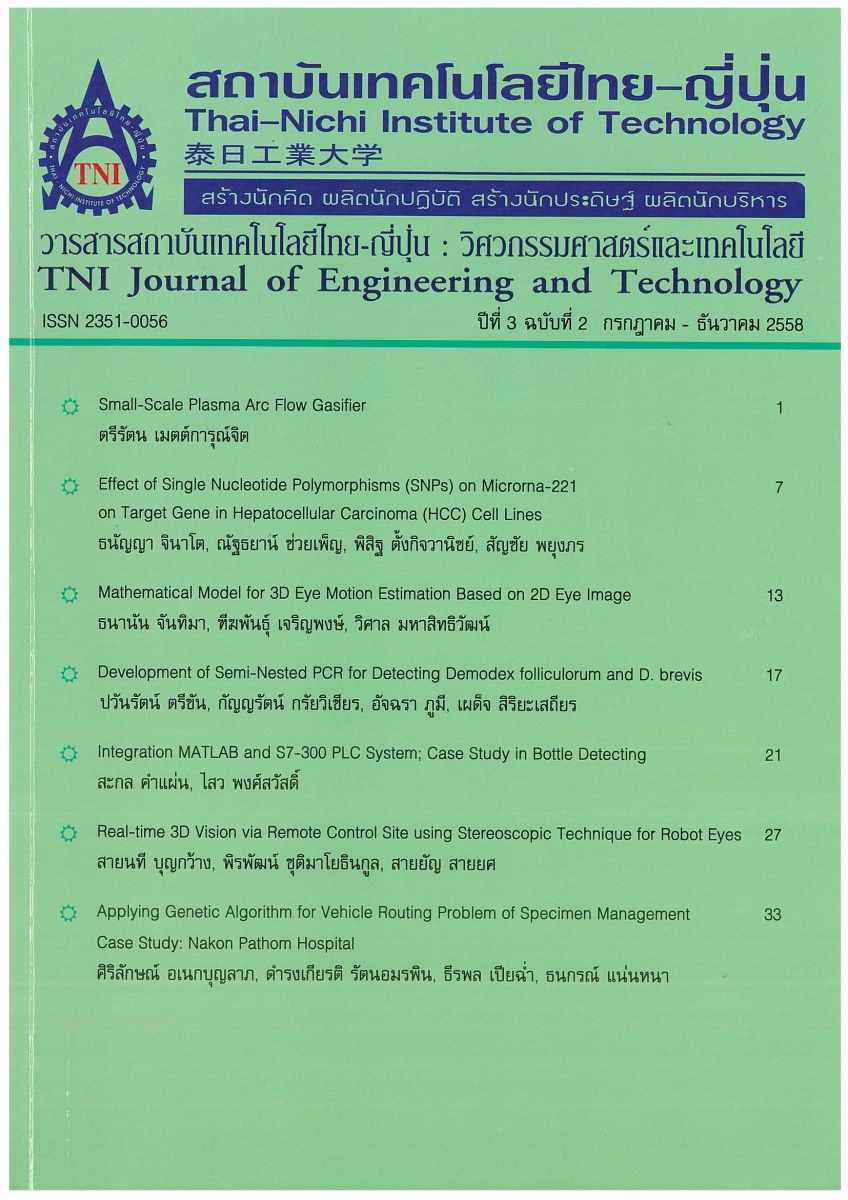ผลของความหลากหลายทางพันธุกรรมบนยีนไมโครอาร์เอ็นเอ-221 ต่อยีนเป้าหมายในเซลล์มะเร็งตับ
Main Article Content
บทคัดย่อ
มะเร็งตับเป็นโรคที่มีอัตราการเสียชีวิจค่อนข้างสูงเนื่องจากมักตรวจพบโรคนี้ในระยะที่มีความรุนแรงของโรคสูง การหา biomarkers เพื่อนำมาช่วยในการวินิจฉัยโรคในระยะเริ่มแรกจึงมีความสำคัญ ซึ่งไมโครอาร์เอ็นเอ (miRNAs) เป็น non-coding RNAs สายสั้นๆ ที่มีบทบาทสำคัญในการควบคุมการแสดงออกของยีนเป็นจำนวนมาก มีการเปลี่ยนแปลงแตกต่างกันในกลุ่มของคนที่เป็นโรคและในคนปกติ นอกจากนี้ความหลากหลายทางพันธุกรรม ที่อยุ่บน miRNA ยังส่งผลต่อการทำงานของ miRNAs ในงานวิจัยนี้จึงต้องการศึกษาผลของความหลากหลายทางพันธุกรรมที่ตำแหน่ง rs113054794 (A/C) บนยีน miR-221 ต่อกลไกการควบคุมการแสดงออกของยีน Aryl hydrocarbon receptor nuclear translocator (ARNT) ในเซลล์มะเร็งตับ (HepG2) ทดสอบโดยการสร้าง miR-221 expression vector แล้วนำเข้าสู่เซลล์ HepG2 และวัดระดับการแสดงออกของ miR-221 ด้วย real-time PCR พบว่ามีการแสดงออกของ miR-221 เพิ่มสูงมากขึ้นถึง 65 เท่าในกลุ่มที่ได้รับ miR-221 expression vector นอกจากนี้ศึกษาการจับกันระหว่าง miiR-221 และยีน ARNT นั้นวิเคราะห์ด้วยโปรแกรม RNAhybrid โดยพิจารณาค่า minimum free energy (mfe) พบว่าความหลากหลายทางพันธุกรรมที่ตำแหน่ง rs113054794 (A/C) บนยีน miR-221 ส่งผลต่อการจับระหว่าง miR-221 และ ยีน ARNT ทำให้ค่า mfe จะมีความแตกต่างกันอย่างชัดเจน (allele C = -25.9 kcal/mol ในขณะที่ allele A = -18.7 kcal/mol) จากนั้นวัดระดับการแสดงออกของยีนเป้าหมาย ARNT ด้วย real-time PCR พบว่า miR-221 ทั้ง 2 alleles มีความสามารถเมื่อเทียบกันกลุ่มควบคุม อย่างไรก็ตาม miR-221 allele A และ allele C สามารถยับยั้งการแสดงออกของยีน ARNT ได้ไม่แตกต่างกันทางสถิติ ดังนั้นจึงสรุปได้ว่า ความหลากหลายทางพันธุกรรมที่ตำแหน่ง rs113054794 บนยีน miR-221 ไม่ส่งผลต่อความสามารถในการควบคุมการแสดงออกของยีน ARNT อย่างไรก็ตามอาจส่งผลต่อการควบคุมยีนอื่นๆ ซึ่งจำเป็นต้องมีการศึกษาต่อไป
Article Details
นโยบายการรับบทความ
กองบรรณาธิการวารสารสถาบันเทคโนโลยีไทย-ญี่ปุ่น มีความยินดีรับบทความจากอาจารย์ประจำ และผู้ทรงคุณวุฒิในสาขาวิศวกรรมศาสตร์และเทคโนโลยี ที่เขียนเป็นภาษาไทยหรือภาษาอังกฤษ ซึ่งผลงานวิชาการที่ส่งมาขอตีพิมพ์ต้องไม่เคยเผยแพร่ในสิ่งพิมพ์อื่นใดมาก่อน และต้องไม่อยู่ในระหว่างการพิจารณาของวารสารอื่นที่นำส่ง ดังนั้นผู้สนใจที่จะร่วมเผยแพร่ผลงานและความรู้ที่ศึกษามาสามารถนำส่งบทความได้ที่กองบรรณาธิการเพื่อเสนอต่อคณะกรรมการกลั่นกรองบทความพิจารณาจัดพิมพ์ในวารสารต่อไป ทั้งนี้บทความที่สามารถเผยแพร่ได้ประกอบด้วยบทความวิจัย ผู้สนใจสามารถศึกษาและจัดเตรียมบทความจากคำแนะนำสำหรับผู้เขียนบทความ
การละเมิดลิขสิทธิ์ถือเป็นความรับผิดชอบของผู้ส่งบทความโดยตรง บทความที่ได้รับการตีพิมพ์ต้องผ่านการพิจารณากลั่นกรองคุณภาพจากผู้ทรงคุณวุฒิและได้รับความเห็นชอบจากกองบรรณาธิการ
ข้อความที่ปรากฏภายในบทความของแต่ละบทความที่ตีพิมพ์ในวารสารวิชาการเล่มนี้ เป็น ความคิดเห็นส่วนตัวของผู้เขียนแต่ละท่าน ไม่เกี่ยวข้องกับสถาบันเทคโนโลยีไทย-ญี่ปุ่น และคณาจารย์ท่านอื่น ๆ ในสถาบัน แต่อย่างใด ความรับผิดชอบด้านเนื้อหาและการตรวจร่างบทความแต่ละบทความเป็นของผู้เขียนแต่ละท่าน หากมีความผิดพลาดใด ๆ ผู้เขียนแต่ละท่านจะต้องรับผิดชอบบทความของตนเองแต่ผู้เดียว
กองบรรณาธิการขอสงวนสิทธิ์มิให้นำเนื้อหา ทัศนะ หรือข้อคิดเห็นใด ๆ ของบทความในวารสารสถาบันเทคโนโลยีไทย-ญี่ปุ่น ไปเผยแพร่ก่อนได้รับอนุญาตจากผู้นิพนธ์ อย่างเป็นลายลักษณ์อักษร ผลงานที่ได้รับการตีพิมพ์ถือเป็นลิขสิทธิ์ของวารสารสถาบันเทคโนโลยีไทย-ญี่ปุ่น
ผู้ประสงค์จะส่งบทความเพื่อตีพิมพ์ในวารสารวิชาการ สถาบันเทคโนโลยีไทย-ญี่ปุ่น สามารถส่ง Online ที่ https://www.tci-thaijo.org/index.php/TNIJournal/ โปรดสมัครสมาชิก (Register) โดยกรอกรายละเอียดให้ครบถ้วนหากต้องการสอบถามข้อมูลเพิ่มเติมที่
- กองบรรณาธิการ วารสารสถาบันเทคโนโลยีไทย-ญี่ปุ่น
- ฝ่ายวิจัยและนวัตกรรม สถาบันเทคโนโลยีไทย-ญี่ปุ่น
เลขที่ 1771/1 สถาบันเทคโนโลยีไทย-ญี่ปุ่น ซอยพัฒนาการ 37-39 ถนนพัฒนาการ แขวงสวนหลวง เขตสวนหลวง กรุงเทพมหานคร 10250 ติดต่อกับคุณพิมพ์รต พิพัฒนกุล (02) 763-2752 , คุณจุฑามาศ ประสพสันติ์ (02) 763-2600 Ext. 2402 Fax. (02) 763-2754 หรือ E-mail: JEDT@tni.ac.th
References
H. B. El-Serag, and K. L. Rudolph, “Hepatocellular carcinoma: epidemiology and molecular carcinogenesis,” Gastroenterology, vol. 132, no. 7, Jun, 2007, pp. 2557-76.
K. Hagymasi, and Z. Tulassay, “[Epidemiology, risk factors and molecular pathogenesis of primary liver cancer],” Orv Hetil, vol. 149, no. 12, Mar 23, 2008, pp. 541-8.
V. Bihrer et al., “Serum microRNA-21 as marker for necroinflammation in hepatitis C patients with and without hepatocellular carcinoma,” PLos One, vol. 6, no. 10, 2011, pp. e26971.
D. P. Bartel, “MicroRNAs: genomics, biogenesis, mechanism, and function,” Cell, vol. 116, no. 2, Jan 23, 2004, pp. 281-97.
A. Muniategui et al., “Quantification of miRNA-mRNA interactions,” PLos One, vol. 7, no. 2, 2012, pp. e30766.
K. Uchino et al., “RNAi therapeutics and applications of microRNAs in cancer treatment,” Jpn J Clin Oncol, vol. 43, no. 6, Jun, 2013, pp. 596-607.
S. Khare et al., “Epigenetics of hepatocellular carcinoma: role of microRNA,” World J Gastroenterol, vol. 19, no. 33, Sep 7, 2013, pp. 5439-45.
W. P. Kloosterman, and R. H. Plasterk, “The diverse functions of microRNAs in animal development and disease,” Dev Cell, vol. 11, no. 4, Oct, 2006, pp. 441-50.
J. Li et al., “Expression of serum miR-221 in human hepatocellular carcinoma and its prognostic significance,” Biochem Biophys Res Commun, vol. 406, no. 1, Mar 4, 2011, pp. 70-3.
P. Pineau et al., “miR-221 overexpression contributes to liver
tumorigenesis,” Proc Nati Acad Sci U S A, vol. 107, no. 1, Jan 5, 2010, pp. 264-9.
J. Yang et al., “Prognostic role of microRNA-221 in various human
malignant neoplasms: a meta-analysis of 20 related studies,” PLoS One, vol. 9, no. 1, 2014, pp. e87606.
G. T. Nguyen-Dien et al., “Genetic polymorphisms in miRNAs targeting the estrogen receptor and their effect on breast cancer risk,” Meta Gene, vol. 2, no. 0, 12//, 2014, pp. 226-236.
J. Brennecke et al., “Principles of microRNA-target recognition,” PLoS Biol, vol. 3, no. 3, Mar, 2005, pp. e85.
Y. Liang et al., “Aryl hydrocarbon receptor nuclear translocator is associated with tumor growth and progression of hepatocellular carcinoma,” Int J Cencer, vol. 130, no. 8, Apr 15, 2012, pp. 1745-54.
Q. Yuan et al., “MicroRNA-221 overexpression accelerates hepatocyte proliferation during liver regeneration,” Hepatology, vol. 57, no. 1, Jan, 2013, pp. 299-310.
Z. Z. Zhang et al., “Hepatitis B virus and hepatocellular carcinoma at the miRNA level,” World J Gastroenterol, vol. 17, no. 28, Jul 28, 2011, pp. 3353-8.
S. O. Yoon et al., “Deregulated expression of microRNA-221 with the potential for prognostic biomarkers in surgically resected hepatocellular carcinoma,” Hum Pathol, vol. 42, no. 10, Oct, 2011, pp. 1391-400.
F. Fornari et al., “MiR-221 controls CDKN1C/p57 and CDKN1B/p27 expression in human hepatocellular carcinoma,” Oncogene, vol. 27, no. 43, Sep 25, 2008, pp. 5651-61.
X. Li et al., “microRNA: a promising diagnostic biomarker and therapeutic target for hepatocellular carcinoma,” Dig Dis Sci, vol. 59, no. 6, Jun, 2014, pp. 1099-107.
M. Rong et al., “Increased miR-221 expression in hepatocellular carcinoma tissues and its role in enhancing cell growth and inhibiting apoptosis in vitro,” BMC Cancer, vol. 13, 2013, pp. 21.

